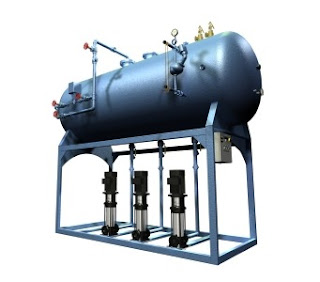 |
| Spray type feedwater deaerator Courtesy Williams and Davis Boilers |
The purpose of a deaerator is to reduce the amount of dissolved oxygen and carbon dioxide in the feedwater. Both of these dissolved gases contribute to corrosion in the boiler and steam system. Oxygen will promote the formation of oxides with metal surfaces, commonly steel, found in most steam systems. Dissolved carbon dioxide in the feedwater will promote the formation of carbonic acid (H2CO3) which is also corrosive to metals.
Feedwater deaerators come in two basic forms. The tray type deaerator will generally have two sections, an upper domed section where feedwater is heated by system steam and dissolved gases liberated from the water, and a lower shell vessel that serves as a collecting reservoir for the degassed water. The spray type deaerator employs a single vessel or tank, with feedwater sprayed into the vessel and heated by system steam. The steam strips the dissolved gases from the feedwater, then maintains the stored feedwater at a temperature high enough to prevent gases from re-dissolving in the feedwater. Both tray and spray systems vent the removed gases.
Williams and Davis Boilers, in addition to manufacturing a broad line of steam boilers, also manufactures spray type deaerators in vertical and horizontal configurations, as well as other steam system ancillary equipment.
Share your steam system challenges with the combustion and steam experts at CTI-Controltech, combining your own process and facilities knowledge with their steam system expertise to develop effective solutions.